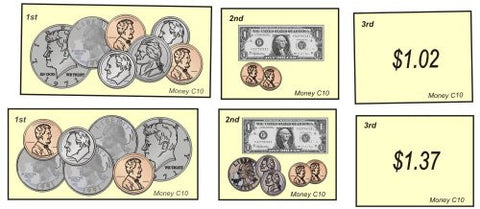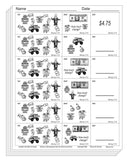Money C
- Last in series of money exercises
- Complex combinations of coins and change scenarios
- For children in grades 2-4
- Three-way cardstock matching cards. Labels for organization and answer keys also included
- Fifteen separate exercises with six problems each
Note: Graphics appear as grayscale on ivory cardstock.
Three-way matching exercises involving large number of coins and change: counting large number of coins and bills, expressing given quantity with different combinations of coins, pricing a combination of items, more challenging change exercises. Graphics printed with black ink on ivory coverstock.
Three-way cardstock matching cards. Labels for organization and answer keys also included. (Lamination recommended for heavy use; cutting required.) Recommended storage (not included): fifteen hardware drawers, boxes, or envelopes.
Blackline masters or digital PDFs for written responses (answer keys included). Recommended storage (not included): file.
Scope and Sequence Chart (Click here)
The teacher's experience and the sequence of skills in the students' basic math program are the best guides in determining which skills should be introduced first. In general, the scope and sequence chart above can be used as a guide.
A number of sets for younger children are "color coded." Some teachers present all the levels with an exercise set, while others prefer to present all the blue (two-digit) exercises, progress to the pink (three-digit), and culminate with the green (four-digit).
Other skills such as Roman Numerals require no prerequisites other rhan an understanding of place value. Such exercises can be presented any time.
We Also Recommend




